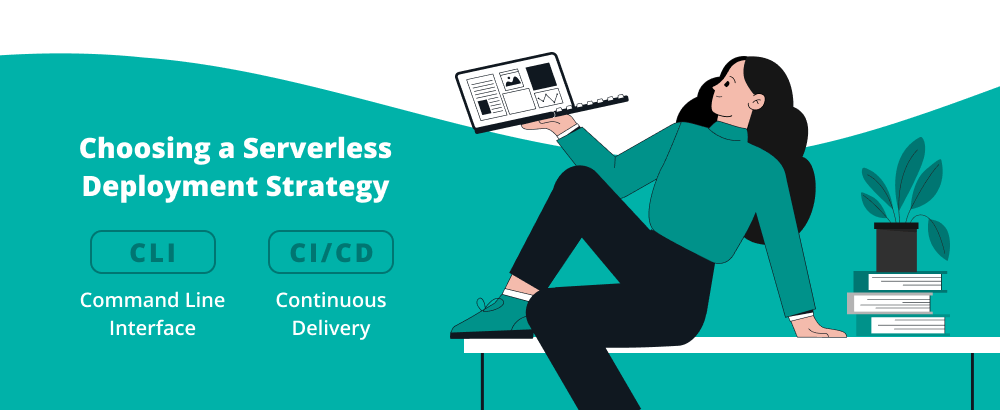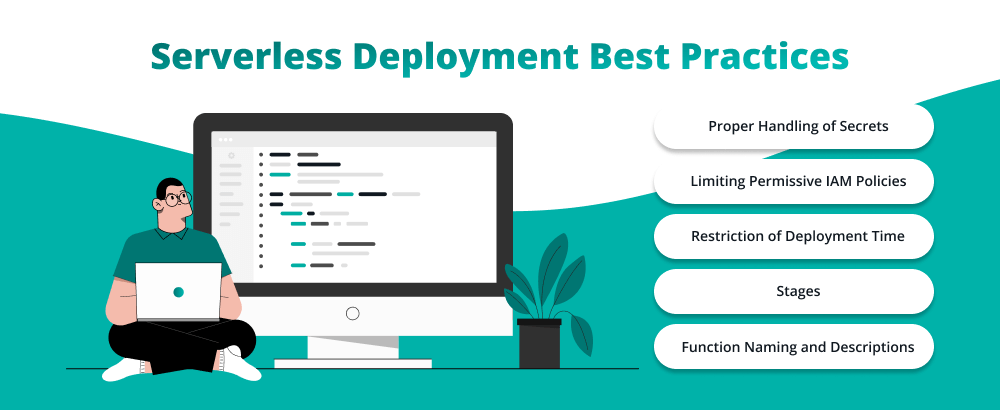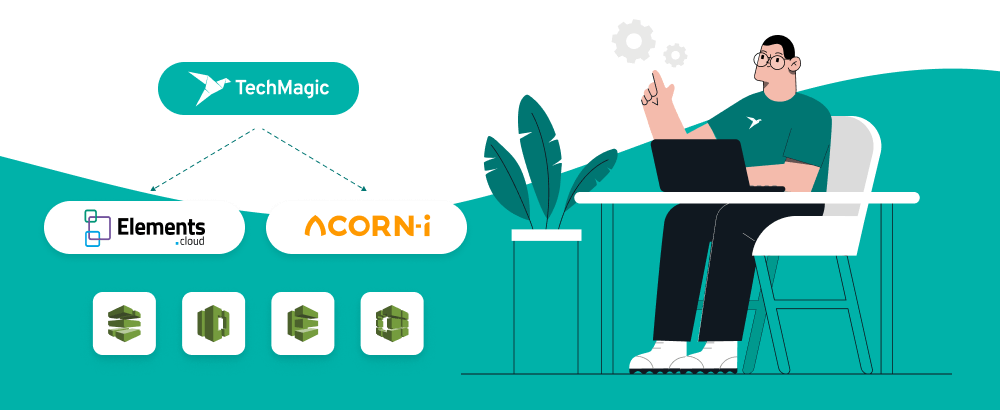Serverless Deployment: How It Works

Director of Cloud and Cybersecurity, AWS Expert, big fan of SRE. Helps teams to improve system reliability, optimise testing efforts, speed up release cycles & build confidence in product quality.

Let's dive into serverless deployment practices together! Learn best practices for this year.
Serverless deployment is one of the latest trends in cloud technologies. It is a development model built for creating and running applications without the need for server management. They are provisioned, maintained, and scaled by a third-party cloud provider, while the developers just write and deploy the code.
Let’s have a closer look at the serverless deployment process, what serverless deployment principles are used, how to deploy a function with serverless, and a few examples.
How Does Serverless Deployment Work?
Serverless deployment is based on two main components: Function as a Service (FaaS) and Backend as a Service (BaaS).
- FaaS is a computing service that is necessary to run stand-alone pieces of code known as functions in the cloud. They are small, short-lived, serve only one purpose, and remain inactive until some event triggers them. Function code is stored in the cloud, but the instance that runs it disappears once the function finishes its task.
- BaaS is a cloud computing service that allows software developers to focus on the frontend while the backend, implemented by someone else, takes place on remote servers. BaaS can include such things as authentication, storage and geolocation services, user management, etc.
Serverless architecture gets rid of the need to think about what runs the code and how. The whole job is done by the provider, who manages computer resources in order to make the process of code execution as smooth as possible.
Read also: Serverless Databases: Pros & Cons, Benefits, Examples on the Market.
Choosing a Serverless Deployment Strategy

The best serverless deployment strategy can be described by the following situation: a reliable service provider grants access to an error-free environment deployed in the cloud. Any modified pieces of code are uploaded in the easiest way possible while all the resources scale automatically according to the workload. Unfortunately, this optimistic scenario of minimum efforts is a rare thing and, in reality, is a little bit more complicated.
In order to start creating applications, you can use the AWS Serverless Application Model (SAM), which has a single deployment configuration, integration with development tools, local testing, and debugging algorithms.
Learn more about the Best Application Deployment Strategies in 2022.
SAM offers two basic strategies for serverless deployment: Command Line Interface (CLI) or Continuous Implementation and Continuous Delivery (CI/CD).
Command Line Interface (CLI)
CLI is an open-source, Lambda-like execution environment giving access to such operations as building, testing, and debugging apps. These operations are defined by SAM templates or can be executed with the help of the AWS Cloud Development Kit (CDK). CLI can be used to deploy the apps to AWS directly.
Once the app is ready, it is necessary to acknowledge its capabilities with the help of the AWS CLI. Further deployment is implemented in three steps:
- Review the app’s requirements. This list is necessary to make the deployment possible.
- Create the changeset. The set of required infrastructure must be provided before the creation of the AWS CloudFormation changeset and its ID. The ID is necessary for the next step.
- Execute the changeset, which is the actual deployment.
Continuous Delivery (CI/CD)
The CI/CD approach is used for the automated deployment of serverless apps. This approach can be easily integrated with both AWS’ original and third-party systems. It is based on the generation of a deployment pipeline for the CI/CD system.
AWS SAM offers a set of starter templates that are used for the fast generation of pipelines with the help of particular commands. These templates use the JSON/YAML syntax of the CI/CD system and implement best practices like the management of artifacts across different accounts and regions and the utilization of the minimum number of permissions necessary for the deployment of the app.
The process of starter pipeline generation consists of four basic steps:
- Creation of AWS infrastructure resources. The pipeline requires particular resources like Identity and Access Management (IAM) users and roles or a particular repository.
- Connection of the Git repository with the CI/CD system. It is necessary to make the system understand what repository will trigger the pipeline and start the process. In some cases, this step can be omitted, as particular combinations of repositories and systems do not need it.
- Generation of the starter pipeline configuration.
- Commitment of the pipeline configuration to the Git Repository. It is necessary to make sure that the CI/CD system knows about the existence of the particular configuration and will continue its operations when the changes are introduced.
The sequence of these steps may vary depending on the type of CI/CD system.
Once the pipeline configuration is generated and committed to the Git repository, any change in the code in that repository will trigger the pipeline to run automatically.
Serverless Deployment Best Practices

When you become more experienced in the deployment of serverless applications, their structure can become more complex, and their scope can start to grow. This makes the implementation of some practices a must. Let’s have a closer look at the best of them.
Proper Handling of Secrets
Some data sets like application programming interface (API) keys or database credentials are secret and need to remain confidential. This is achieved by keeping them under control, limiting access to them, and using different secrets for different apps. It is recommended to use specialized tools for secrets management, like Vault by HashiCorp.
Limiting Permissive IAM Policies
One more practice includes limiting the scope of permissions granted to the apps. Every time an IAM policy for a service is created, it is necessary to limit IAM roles to the minimum number that allows them to operate in the way they should. The number of wildcards in the policy’s definitions should also be as small as possible. One more thing that can be done is to restrict usage of the wildcards for the entire development team.
Read also: Top Serverless Monitoring Tools in 2022.
Restriction of Deployment Time
There are some periods of time when serverless deployment should be restricted — for example, high sales seasons. Even though the development team may be confident in the quality of the code, they should do their best to avoid all the bugs that may spoil the customer experience. The solution is to limit the new deployments during this period.
Stages
Conventions are a useful thing. They are necessary to help developers learn different standards and then use them to understand other parts of the system intuitively. One of the most widely-spread conventions is based on the notion that the code seen by the customers and the code being worked on are kept in different places. They are known as stages and are used as bricks to pave the road for the code towards the customers.
Stages offer a wide range of configurations, starting with what account or location they are deployed to and finishing with what secrets or parameters are used.
Function Naming and Descriptions
Using clear names and descriptions in the infrastructure is an effective way to explain what different services do and how they are interconnected. It also makes the process of debugging easier.
It is widely accepted that the serverless deploy function should contain the service name, stage, and function inside of its name. It makes the search process of a particular function much faster and more convenient.
TechMagic’s Serverless Deployment Examples

Transition to the cloud infrastructure is a modern solution for a growing business. It helps to cut expenditures and get all the advantages of both agility and scalability. Techmagic delivers cloud migration services and implements all serverless deployment stages for businesses of any size and industry.
Techmagic delivers high-quality solutions in the field of serverless deployment. The experts are eager to discuss all aspects and needs of the serverless project, deliver all the necessary services, and offer a customer-oriented approach to cloud consulting.
Read also: Importance of Security in Serverless Technologies.
Techmagic developers are true professionals in such services as AWS Lambda, API Gateway, AWS DynamoDB, and AWS Step Functions. Each developer has certified expertise, guaranteeing that your desired results will be achieved.
Serverless deployment can be a challenging, time- and resource-consuming process. And Techmagic cloud solution architects are ready to make it run smoothly.
The successful implementation of the two following cases demonstrates a high level of professional expertise.
Elements Cloud
Elements Cloud is a business process visualization app.
The challenge for this project was to create a software as a service (SaaS) product with Salesforce integration for Fortune 5000 companies. The technical challenge was to build a similar web tool with backend architecture on AWS. You can learn how Techmagic solved the case here.
ACORN-I
ACORN-I is an intelligent platform that empowers brands’ online presence and maximizes returns from e-commerce investments.
The challenge of the project was to create a new platform that would give clients the opportunity to use it on their own. There were some additional conditions, of course, like a user-friendly interface, modern user experience concepts, and ease of use. The delivered solution is described here.
Conclusion
In this article, we have tried to answer the question “What is serverless deployment?” In recent years, the popularity of this technology is growing at a fast pace, and this trend is likely to continue. As more and more companies understand how convenient it may be, the number of players providing digital solutions is growing accordingly.
Those who implement the best strategies and practices and make the serverless deployment process reliable and transparent for the customers will definitely get their market share.
As an AWS web development company based in Lviv, Ukraine, TechMagic helps its clients to grow their business through different technologies. If you ask yourself how to implement a serverless deployment strategy and would like to conduct an expenditure assessment — or if you have any plan or project and would like to discuss it with our engineers — feel free to contact us through our contact form and get a detailed consultation and learn more about AWS serverless solutions.
You can also check our case portfolio to have a close look at our past projects.



 Software Development
Software Development
 Security Services
Security Services
 Cloud Services
Cloud Services
 Other Services
Other Services
















 TechMagic Academy
TechMagic Academy
 linkedin
linkedin
 facebook
facebook
 twitter
twitter






















